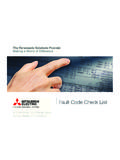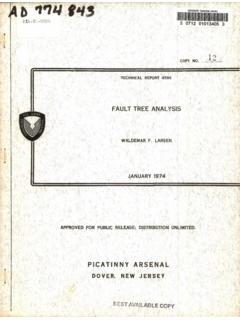Transcription of FAULT FINDING MANUAL PPOINT - Tonga Charter
1 FAULT FINDING MANUALFor Self Excited and Separately Excited GeneratorsSAFETY PRECAUTIONSB efore testing the generating set, read the generating setInstallation MANUAL , and this FAULT FINDING MANUAL , and becomefamiliar with it and the AND EFFICIENT OPERATION CAN ONLY BEACHIEVED IF THE EQUIPMENT IS CORRECTLYINSTALLED, OPERATED AND accidents occur because of a failure to follow fundamentalrules and SHOCK CAN CAUSE SEVEREPERSONAL INJURY OR DEATH. Ensure installation meets all applicable safety and localelectrical codes. Have all installations performed by qualifiedInstallation technicians. Do not operate the generator with protective covers, accesscovers or terminal box covers removed. Disable engine starting circuits before carrying outmaintenance. Disable closing circuits and/or place warning notices on anycircuit breakers normally used for connection to the mains orother generators, to avoid accidental all IMPORTANT, CAUTION, WARNING, and DANGER notices, defined as:Important !
2 Important refers to hazard or unsafe methodor practice, which can result in productdamage or related equipment !Caution refers to hazard or unsafe method orpractice, which can result in product damageor personal refers to a hazard or unsafe methodor practice, which CAN result in severepersonal injury or possible refers to immediate hazards, whichWILL result in severe personal injury to our policy of continuous improvement, details in this MANUAL which werecorrect at time of printing, may now be due for amendment. Information includedmust therefore not be regarded as "LIVE" EQUIPMENTIt is essential that all test instruments areregularly checked for safety, and anyconnection leads, probes, or clips, arechecked to ensure that they are suitable forthe voltage levels being attempt to test a "LIVE" generatorunless there is another competent personpresent who can switch off the power supplyor shut down the engine in an expose "LIVE" connections unless youhave created a safe working area around sure you have made all other persons inthe immediate area fully aware of what youare FINDING MANUALSECTION 1 Recommended Metering and Test InstrumentsSECTION 2 Electrical TerminologySECTION 3 FAULT FINDING method A , for All GeneratorsSECTION 4 FAULT FINDING method B , for Self-Excited Voltage Regulator is powered from the Generator 5 FAULT FINDING method B.
3 For Separately Excited GeneratorsAutomatic Voltage Regulator is powered from the Permanent Magnet 6 Parallel Operation and FAULT FINDING for All Generators4 SECTION 1 RECOMMENDED METERING AND TEST INSTRUMENTSTo successfully carry out the various test procedures suggestedin this MANUAL , certain test instruments are essential. Thefollowing lists detail the basic requirements in this should be noted that in addition to these instruments acomprehensive kit of tools is also essential. For FAULT findingpurposes this need not include any specialised 1 - MultimeterThe Multimeter is a comprehensive test instrument for measuringvoltage, current and resistance. It should be capable ofmeasuring the following ranges:-Voltage A C0-250-500-1000 VoltsVoltage D C0-25-100-250 VoltsAmperes D C0-10 AmpsD C Resistance0-10k (ohms) or 0-2k (ohms)0-100k (ohms) or 0-20k (ohms)0-1M (ohms) or 0-200k (ohms)Item 2 Tachometer or Frequency meterThis instrument is for measuring the shaft speed of the alternatorand should be capable of measuring speeds between 0 and 5000revolutions per minute, (RPM).
4 An alternative to the tachometer is the frequency meter (seeSection 2 on Frequency and Speed, for details). However thealternator must be generating its normal output voltage for thisinstrument to be 3 Megger (Insulation test meter)This instrument generates a voltage of 500V or 1000V, and isused to measure the resistance value of the insulation to earth(ground). It may be an electronic push button type, or a handcranked generator 4 - Clip-On Ammeter (Clampmeter)Used to measure A C current, it consists of a pair of callipers,which are clamped around the conductor, and by means of atransformer action, gives an indication of the amperes flowing inthe conductor. Useful ranges to have on this meter are:-A C Amps 0-10-50-100-250-500-1000 Item 5 Kelvin Bridge low resistance meterThis instrument is used to measure resistance values below They are bulky, and expensive, but are the only means ofaccurately measuring very low resistances, such as main statorand exciter rotor , there are other methods of testing low resistancewindings, and these are included in the various test procedures, Test Method A (Section 3).
5 This section will enable the maingenerator windings to be tested while running the generator atnormal speed without is essential that all test instruments beregularly checked for safety, and anyconnection leads, probes or clips checked toensure that they are suitable for the voltagelevels being attempt to test a "LIVE" generatorunless there is another competent personpresent who can switch off the power supplyor shut down the engine in an expose "LIVE" connections unless youhave created a safe working area around sure you have made all other persons inthe immediate area fully aware of what youare kVA to kVADo not attempt to carry out tests on mediumor high voltage generators without usingspecialised instruments and probes, withsuitable protection equipment andprocedures for grounding (earthing) theoutput 2 ELECTRICAL TERMINOLOGY AND RESISTANCESVOLTAGE AND CURRENT (AMPERES)An AC Generator is designed to produce a voltage level suitablefor the load to which it is connected.
6 The control circuits aredesigned to automatically maintain this voltage level as the loadis increased or large changes in loading will produce temporary changesin the voltage. The control circuit is designed to recover to astable condition as quickly as current drawn from the AC Generator is determined by theamount of load connected to it. Current creates a temperaturerise in the windings, hence the requirement for drawing airthrough the AC Generator by means of the fan. If the full loadrated current is exceeded on any phase of the main statorwindings, it will result in overheating in this winding. Similarly, anyrestriction in the flow of air through the machine will result in arapid increase in the temperature of the (Hz) and Speed (RPM)An AC Generator is a constant speed device, and should not beoperated at speeds above 4% of the rated speed, or more than1% below the rated changes will create temporary changes in the speed, butthe engine must be capable of returning to the steady statecondition within a few speed requirements for the AC Generator are determinedby:-(a) The frequency (Hz) requirement of the load(b) The number of poles,( main rotor coils), in the generatorFrequency (HZ) =This can be shown more clearly in a chart: -Frequency (Hz)Speed ( )No.
7 Of Poles(rotor coils)5015004601800450100066012006503000 26036002 From this chart, a simple formula is produced to calculate thespeed from the frequency, or vice pole machine 1 cycle (Hz) = 30 pole machine 1 cycle (Hz) = 20 pole machine 1 cycle (Hz) = 60 (kW) kilo Volt Amperes (kVA) and PowerFactors (pf.)For an AC Generator to supply power for a load of 1kW, theprime mover (engine) driving the alternator must produceapproximately are calculated by the formula: -kW =kVA (kilo Volt Amperes), are calculated by the formula:-kVA =Both equations are multiplied by 3 ( ) for a 3 FactorThe Power Factor (pf), is a measure of wasted current, which is aproduct of inductive loads such as motors, transformers,(magnetic circuits), and some forms of formula for calculating the Power Factor is:-pf =Unity Power Factor (pf 1)Purely resistive load, heating, tungsten filament lighting, has apower factor of one, (pf 1), and contains very little Wattless(inductive) load, which is power factor zero, (pf 0).
8 An AC Generator will deliver continuously the rated full loadcurrent at any power factor between pf 1 (unity) and , the prime mover, (engine), is greatly affected by thepower factor. At pf 1, the kVA and kW are equal; therefore theengine is supplying 20% more kW load at pf 1, than it is at pf is important, therefore, that this is taken into consideration,when approaching 75% to 100% load current of the Generator,with a power factor higher than x Amperes x Power Factor1000 Volts x Amperes1000kilowattskVAN (speed) X P (pairs of poles )60 (sec s)kVAkVArkWCos Phi Power Factor6 Lagging Power FactorsA Generator is designed to deliver the full load current at anypower factor between unity and lagging. Certain loads have apower factor lower than 0,8 lag, welding transformers;autotransformer, start motors, gas discharge lighting. A reductionin the full load (kVA), rating is required for a lagging pf lower Power FactorsCapacitive load some fluorescent lighting, power factorcorrection capacitor banks, produce leading power factor latter is required by the Electricity authorities to improve thecustomers lagging power factor.
9 The capacitor bank size ismeasured in kVAr (reactive).A purely Capacitive load can cause the Generator control system,(AVR), to loose control, creating voltage instability, and possiblehigh voltage from the is due to the fact that, unlike most loads, which are pf 1,(unity) or lagging pf, a leading pf load current will cause theGenerator excitation voltage to decrease, as the load the control system will be unable to control theGenerator excitation level, and voltage instability will degree of instability is determined by the kVAr size of thecapacitors, relative to the kVA size of the load can present a problem for mains failure (standby)Generators. When the mains electricity supply fails, all motor,(inductive), load is disconnected by the individual , when the Generator is connected to the system,the load will mainly consist of lighting, and possibly the powerfactor correction capacitors.
10 In this situation the AC Generator willsee a very low, (leading), power factor, and may becomeunstable, and/or generate high order to prevent this situation, it is advisable to ensure that thepower factor correction capacitors are switched OFF when thegenerator takes the initial advice in this respect may be obtained from Newage AVK SEG if - measuring component valuesWhen FAULT FINDING it is necessary to measure the resistancevalues of components and windings, and compare them withknown normal values, in order to identify a faulty winding. Thenormal resistances of the windings are given in the windingresistance charts, in the generator installation and maintenancehandbooks, service and maintenance values above 10 ohms can be measured accuratelywith a multimeter. Between and 5 ohms a multimeter has alimited accuracy, and other test methods may be between And 5 OhmsThe resistance value of a winding such as a brushless main rotorwill be between and 3 ohms.




